The results of the 2024 Singapore and Asian Schools Math Olympiad (SASMO) are finally out! With the increased difficulty this year, how did your child perform? Did they achieve the ranking you were hoping for? This blog will provide a detailed analysis of the 2024 results, help you understand the performance report, and offer insights into the competition’s difficulty.
2024 SASMO Results Overview
SASMO, founded in 2006, has grown from 155 local participants in Singapore to 57,060 participants from 7,333 schools across 38 countries in 2024. It is one of the largest math contests in Asia, open to students from Primary 1 to Junior College 2 (G1-G12). The competition is organized by the Singapore International Math Competition (SIMCC).
Results Summary
This year, SASMO saw a diverse range of participants and impressive performances. Although the detailed results for Singapore have not yet been fully compiled, we have the statistics for China, Hong Kong, and Macau.
- China:
- Perfect Score: 4
- Gold: 484
- Silver: 714
- Bronze: 1,607
- Honorable Mention: 568
- Hong Kong & Macau:
- Gold: 62
- Silver: 81
- Bronze: 187
- Honorable Mention: 50
Estimated 2024 SASMO Cut-off Scores
While SASMO does not officially release cut-off scores, we have estimated them based on a substantial sample of participants’ results. Here are the projected cut-off scores:
| Grade | Gold | Silver | Bronze |
|---|---|---|---|
| G1 | 60 | 52 | 36 |
| G2 | 63 | 48 | 36 |
| G3 | 57 | 48 | 37 |
| G4 | 64 | 56 | 40 |
| G5 | 63 | 53 | 37 |
| G6 | 66 | 57 | 39 |
| G7 | 55 | 46 | 38 |
| G8 | 58 | 48 | 38 |
| G9 | 55 | 45 | 35 |
| G10 | 50 | 42 | 33 |
| G11 | 52 | 42 | 33 |
| G12 | 57 | 56 | 45 |
Based on this year’s estimates, we can conclude:
- The difference between the Gold and Silver awards is approximately 10 points, which equates to about 3-5 questions.
- The difference between the Silver and Bronze awards is also approximately 10 points, or about 3-5 questions.
- Additionally, the difference between the Bronze and Honorable Mention awards is around 5 points, or about 2-3 questions.
- This year’s exam was more challenging than last year’s, resulting in lower cut-off scores.
Award Distribution
SASMO recognizes top-performing students with various awards:
- Perfect Score Award: For students with full marks, including a special certificate and personalized medal.
- Gold Award: Top 8% of participants.
- Silver Award: Next 12% of participants.
- Bronze Award: Next 20% of participants.
- Honorable Mention: Next 10% of participants.
- Participation Certificate: For the remaining 50% of participants.
Top 40% of participants receive a physical certificate and a medal, and are invited to compete in SIMOC 2024.
Understanding the SASMO Performance Statistical Report
A Quick Review of Exam Format and Scoring
SASMO tests are 90 minutes long and have different papers for each grade level. The test consists of 25 questions divided into two sections: 15 multiple-choice questions and 10 non-routine questions. The maximum score is 85 points, and each student begins with 15 points to avoid negative scores.
Here’s a breakdown of the scoring:
- Section A: 2 points for each correct answer, 0 for unanswered, and -1 for incorrect.
- Section B: 4 points for each correct answer, no penalty for wrong answers.
Performance Report Breakdown
The SASMO Performance Statistical Report helps students and parents understand their performance in detail. The report not only highlights their strengths and areas for improvement across different topics, but also includes a comparison of their performance with that of their peers in the same grade, both within their school and country/territory. The report is divided into four main parts:
Part 1 Performance by Questions
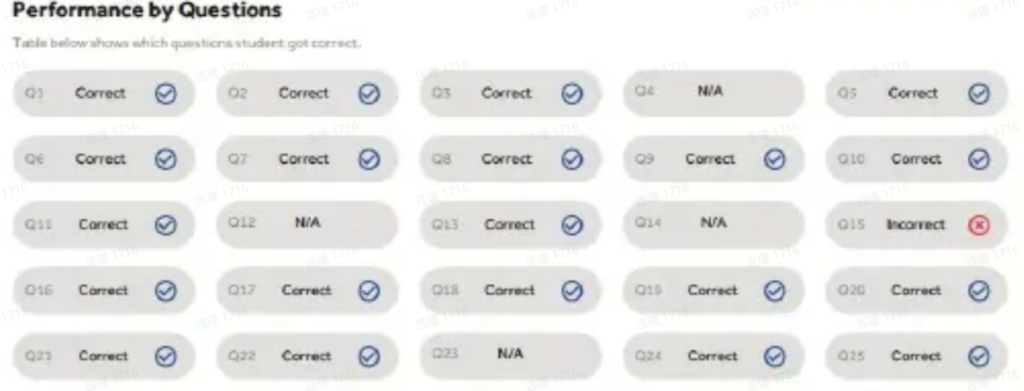
This section lists which questions the student answered correctly, incorrectly, or left unanswered. No need to calculate the score by yourself, as there is another report that directly shows your performance, which will be detailed later.
Part 2 Performance by Topic

This part shows the student’s accuracy by topic compared to their school and national averages. There is a total of nine topics across 12 grades. For example, the following screenshot shows a student’s correct answer rate in “Arithmetic” is 83%, while his or her school average is 60% and the national average is 67%.
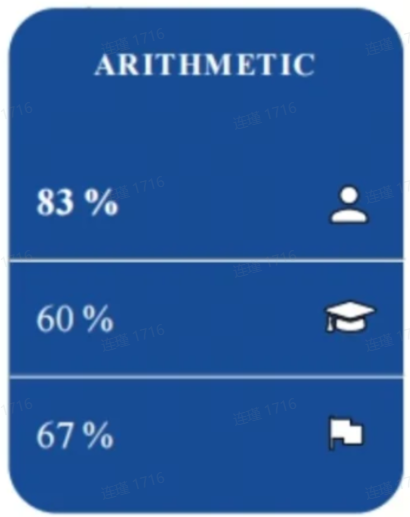
Part 3 Grade Performance Analysis
Here, the student’s score in each topic is compared to the range and average scores of their peers in the same school. This helps in understanding the relative performance within the school.
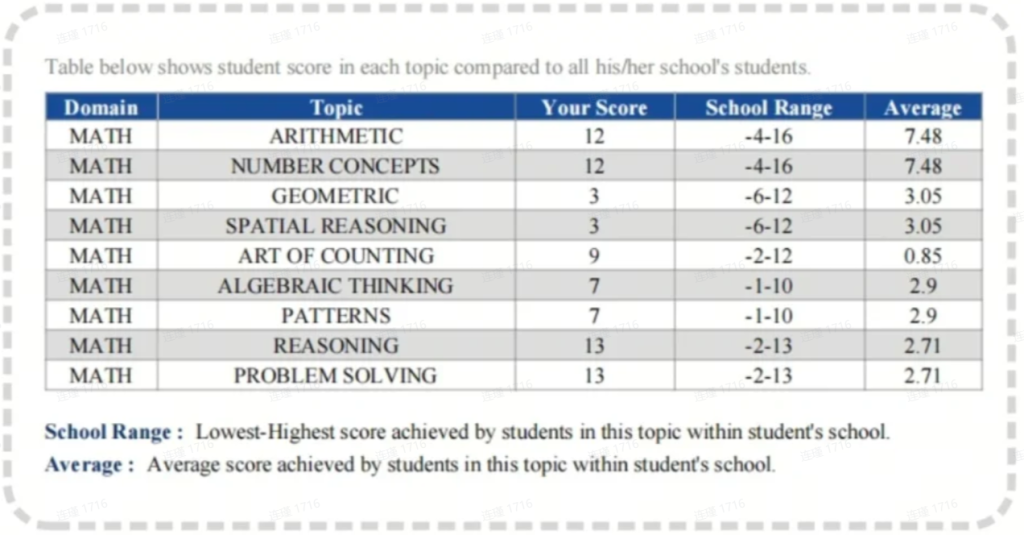
What should be noticed is that adding up all scores of various topics is not equal to the student’s final score because some problems simultaneously belong to 2 or 3 topics.
Part 4 Analysis by Question
This section provides a detailed analysis of each question, including the topic it covers, whether the student answered it correctly, and the overall correct response rates at the school and national levels. It also highlights the difficulty of each question.
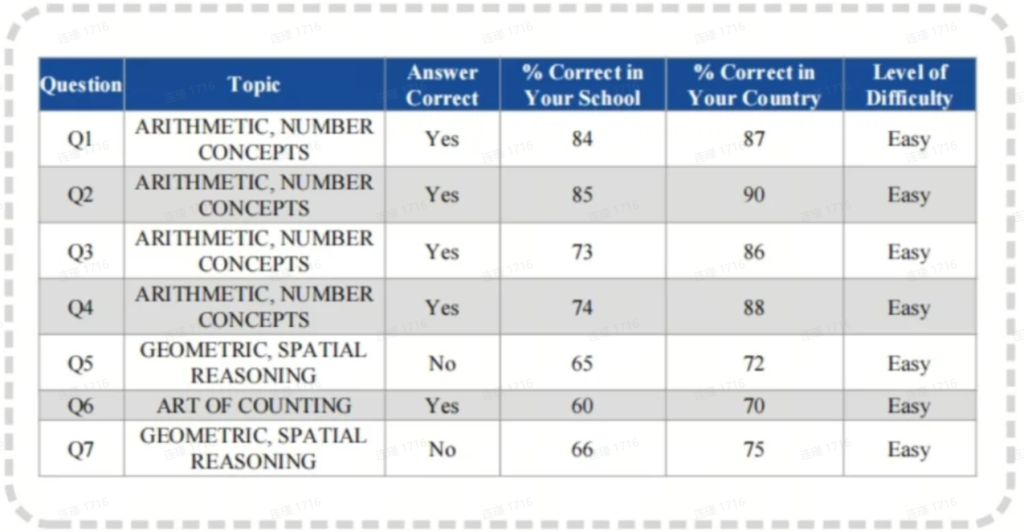
Additionally, participants can access another detailed report (see below) by logging into the SIMCC member development portal. This report provides the final score (top right corner) of each participant, their awards, global ranking, national ranking, school ranking, and performance in different topics.
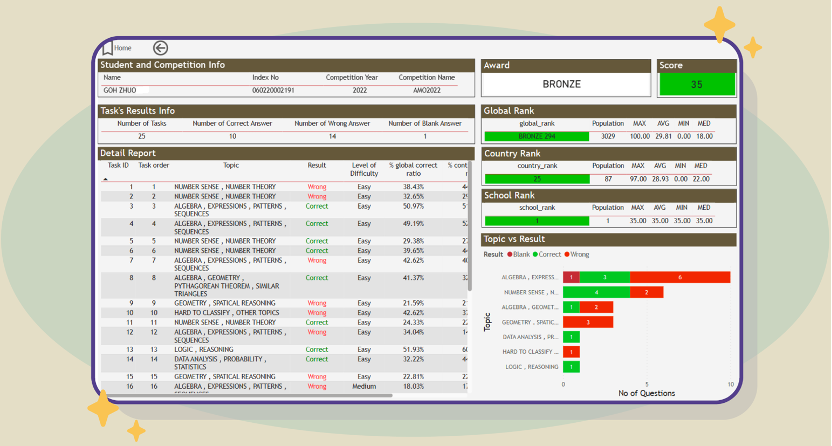
2024 SASMO Exam Difficulty Analysis and Past Papers
Difficulty Analysis
Many participants and parents reported that the 2024 SASMO exam was more challenging than previous years. This year, there were only five Perfect Scorers (4 from China and one from Vietnam) compared to 69 last year. Here’s a detailed analysis of the difficulty across different topics:
Arithmetic: Students found the arithmetic problems to be manageable and similar to what they had encountered in past exams.
Number Concepts: These questions, which are primarily focused on understanding basic number concepts, also maintained a consistent difficulty level. This topic mainly targets lower grade levels and was found to be as challenging as in previous years.
Algebraic Thinking: The questions involving algebraic operations and thinking remained consistent in difficulty.
Patterns: The pattern recognition questions were notably more difficult this year. While both lower and higher grade levels had pattern questions, the higher grade questions were especially challenging, requiring more advanced problem-solving skills.
Geometric: Geometry has always been a tough section in SASMO, but this year, it was even more challenging, particularly for lower grades. The geometry problems in SASMO for grades 4 to 6 already exhibit similar difficulty levels as those in AMC 8.
Spatial Reasoning: The spatial reasoning questions, which test students’ ability to visualize and manipulate objects in space, maintained a similar level of difficulty as in previous years.
Art of Counting: Counting problems in SASMO have a classic style, often involving geometric counting, such as finding all triangles in a given figure. This topic remained consistent in difficulty.
Reasoning: Logical reasoning questions were more difficult this year. These questions required students to apply higher-order thinking skills, making this section a tougher challenge compared to previous years.
Problem Solving: The problem-solving section, which includes applied math problems, maintained its usual level of difficulty. This section often tests knowledge beyond the current grade level, such as G4 students encountering G6-level percentage problems.
In summary, the 2024 SASMO exam presented increased difficulty in several key areas, particularly in pattern recognition, geometry, and logical reasoning.
Past Papers
Research into past SASMO papers reveals a high level of consistency in question types, making it beneficial for students to practice with previous years’ papers. For those interested, apart from SASMO’s official past papers (2019-2020), the 2024 papers (G1-G6) are also available upon request via @sparkedu.sg.
Preparing for SIMOC
Students who rank in the top 40% of SASMO participants are eligible to compete in the Singapore International Math Olympiad Challenge (SIMOC), which will be held from July 20-23, 2024, in Singapore. This provides an excellent opportunity for top-performing students to further demonstrate their skills.

For parents and students, it’s essential to celebrate the achievements in SASMO and use the detailed performance reports to identify areas for improvement. Encourage younger students to participate and improve while motivating high achievers to prepare for SIMOC. At Spark Education, we offer specialized competition training courses to help students excel in these prestigious math contests. Last year, Spark Education students achieved outstanding results in SASMO, thanks to our professional and experienced teachers and well-designed, engaging courses.
Try our free trial class today and stay tuned to our blog for more updates and tips on math competitions. Together, let’s help your child achieve their mathematical potential!




